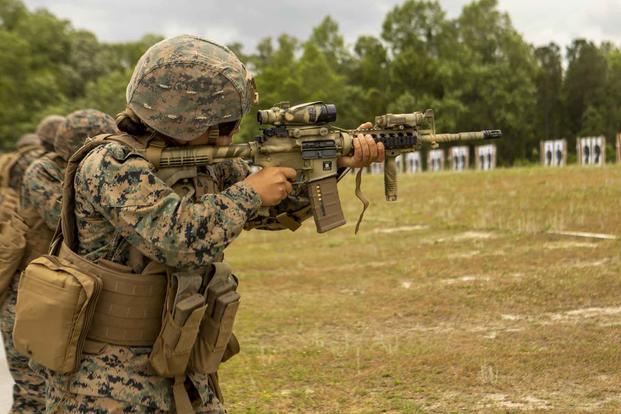The Marine Corps has published new marksmanship guidelines, shifting how Marines are scored on their annual rifle qualifications and how those in the early stages of training are initially tested.
The changes, which were released Monday and are effective immediately, include a greater focus on getting Marines to shoot at expert levels versus mere completion of their annual rifle qualification.
Col. Greg Jones, the commanding officer for Weapons Training Battalion at Marine Corps Base Quantico in Virginia, said Marines should "be proud of the service for being really, really serious about finding better pathways to train to increase their lethality."
Read Next: Ospreys Cleared to Fly Again After Deadly Crash Despite Mechanical Failure with Unknown Cause
"So, when they do go downrange, they're better able to defend themselves and their peers," he added.
Under the latest version of Marine Corps Order 3574.2, Marines will no longer be allowed to accept marksman or sharpshooter scores on pre-qualification day at the range. Only those who shoot at the expert level will still be allowed to accept the score and opt out of the rest of the qualifying portion of their annual rifle qualification, or ARQ.
"We don't want [Marines] to accept less than only [their] best effort," said Chief Warrant Officer 4 Joshua Grayek, director of Marine Corps marksmanship. The motivation for the move is similar to the 2023 update allowing Marines more than one chance per year to pass their annual qualification.
Another update will allow Marines to shoot in the prone position while using the magazine as a sort of bipod support for their rifle. Previously, this was allowed only while zeroing during the Table 1 phase -- which is shot in various positions from the 200-, 300- and 500-yard lines.
The change is reflective of the newer and higher-quality Magpul magazines used, compared to the metal magazines of old, Jones said. He added this is a prime example of more changes to come that prove the Marine Corps is working to "cross-pollinate best practices from other advances in marksmanship over to entry-level training."
Marines training at the various Schools of Infantry and the Basic School will now be allowed to use the rifle marksmanship assessment, or RMA, instead of finishing Tables 3 and 6, which fleet Marines will still be required to complete. These tables traditionally include shooting with night-vision goggles and firing at targets posted at unknown distances, skills that are similarly included in the RMA, just under new scoring standards.
According to Grayek, the RMA offers a better system of scoring that gives Marines more accurate feedback and therefore should allow them a greater chance at improving.
"For most legacy marksmanship, the only evaluation criteria was where the bullet landed on the target," Grayek said. "But now we're quantifying how quick your first shot was, how fast you can present to the target, how fast you can reload, and then presented again for your follow-up shots."
Through the RMA, Marines will be given feedback on every single round, Jones said. Officer trainees will undergo a similar assessment tailored to the more-limited timeline of the Basic School.
It builds on the increased difficulty added in 2021 updates to the ARQ, a test first established in the early 1900s, and uses updated data analytic systems, like the MantisX BlackbeardX system, to give Marines what they need to be their most lethal selves, Grayek and Jones said. The instructor-to-shooter ratio will also be smaller, allowing for more individualized help and feedback.
The order also notes that updates will be made to the combat pistol program, or CPP. Jones and Grayek clarified this will include scoring shots on target along the same standards as rifle qualification, which have to hit "more lethal" spots like the head and chest.
The changes are thanks to an assessment started about five years ago that essentially revealed Marines are not good at four things when it comes to their marksmanship, Jones explained.
The lethality assessment showed that Marines "don't do a very good job shooting while moving, shooting at moving targets, and shooting at an unknown distance." The fourth thing was that the service wasn't collecting enough data to appropriately assess marksmanship, Jones said.
That led in 2022 to changes to how Marines in the fleet are supposed to qualify on the range, including shooting from positions more closely resembling those found in combat situations while also wearing the same flak vests and kevlar Marines wear when forward-deployed. In the latter half of 2023, the changes dictated in the updated order were phased in aboard the recruit depots and the Schools of Infantry. The early results from those changes appeared promising, according to Jones and Grayek.
"The data analytics really just brings 21st-century information-age technology down to the level of every Marine to help them be more lethal," Jones said. "This helps us be the most ready when the nation's least ready, and we're not going to rest on our laurels just because we're in a time of peace."
Related: Marine Corps Rifle Qualification Is Getting Its First Major Overhaul in More Than 100 Years











